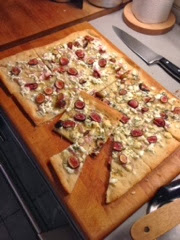It's time to start figuring out what you are going to do with all of the beautiful Basil growing in your garden. Basil is a very popular choice. It's easy to grow, depending on the overnight heat, it will grow like crazy - even in a window box. It's a wonderful herb if you only have a small space or a window box, fire escape, or whatever as long as it has sun and warmth and water it will do very well. Basil is also a versatile herb. It's great in sauces, soups, eggs, and makes delicious flavored oils. And of course, Basil is the main ingredient in traditional Pesto. A jar of pesto will hold well in the refrigerator for a couple of weeks if you keep a half inch or so of extra virgin olive on top of the pesto as you use it.
For long term storage of my tons of beautiful Basil, I use three basic techniques:
Freeze leaves
Freeze a purée of leaves and extra virgin olive oil
Freeze Pesto
For the first technique, wash and dry your Basil (always wash any herbs before you use it; you never know who's set up housekeeping in there!). Pat it dry, pull the leaves from the stems and add the leaves to a good freezer bag. After you fill the bag squeeze out all of the air, label and pop it
in the freezer. The leaves will turn black but they will maintain their flavor for sauces, soups, etc. When you take leaves out let them sit for a few minutes to defrost and give off excess moisture.
For the second technique, just add the leaves - treated as above - to your blender with extra virgin oil and just a touch of kosher salt. Purée the mixture and pour it into ice cube trays. Now I know you may have to go out and buy ice cube trays because of the ice making capabilities of many refrigerators but it's worth it. Plastic trays stack together nicely for storage and if that ice maker ever goes south - you're ready! When the "cubes" are frozen, pop them out, put them in a good freezer bag, label it and put it in the freezer. With a couple of cubes, you have a delicious fat for pan roasting fish, steaming clams, spreading on hot bread or just tossing with hot noodles. Wherever your imagination takes you, they are very versatile. I can tell you that they don't work as cubes in a Bloody Mary - nope not at all. Trust me. It's an oil thing!
The last technique uses the blender method but does it with actual Pesto in place of just leaves and olive oil. I keep the cheese out of my Pesto cubes but I do add the Basil, the extra virgin olive oil, garlic cloves to taste and a bit of salt to the blender and give it a good whirl. When it's incorporated I add some pine nuts and just stir them through. Pour into the ice. Use trays and repeat the freezing and bagging process. I like to vary the pesto a bit; I'll freeze a bag of "spicy" pesto (with some dry hot pepper flakes blended in), and a "traditional" pesto mixture. Be sure to mark your bags!
Note: I am not a fan of dried basil. Some herbs, like oregano and marjoram, develop wonderful flavors when they are dried. In my opinion basil loses flavor when dried. I always dry a little because I have so much, but I try to use it quickly and invariably I don't use it all.
With these techniques - especially the second and third ones, you can walk in the door on a weeknight and have a nice start on something delicious. And if you look in the cold cases at the supermarket you'll notice these "flavor starts" packets or whatever the various manufacturers call them. The packages say that you should just start with the cube or envelope and add your ingredients. Well I have to say, somewhere in the mix of those things are olive oil and herbs. But - and this is a big but - there's a ton of chemicals and additives in there too.
Yours will be pristine and delicious!
A Jar of Homemade Pesto
Some of My Genovese Basil









